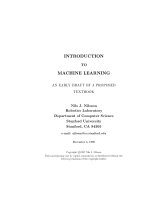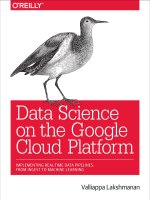Introduction to machine learning
Bạn đang xem bản rút gọn của tài liệu. Xem và tải ngay bản đầy đủ của tài liệu tại đây (2.52 MB, 30 trang )
Introduction to Machine Learning
Tanujit Chakraborty
Indian Statistical Institute, Kolkata.
Email:
July 10, 2019
Talk by Tanujit Chakraborty
Workshop on Data analytics
Statistics
“Statistics is the universal tool of inductive inference, research in
natural and social sciences, and technological applications.
Statistics, therefore, must always have purpose, either in the pursuit
of knowledge or in the promotion of human welfare”
- P.C. Mahalanobis, Father of Statistics in India.
Role of Statistics:
1
making inference from samples
2
development of new methods for complex data sets
3
quantification of uncertainty and variability
Remember: “Figure won’t lie, but liars figure”
Talk by Tanujit Chakraborty
Workshop on Data analytics
Machine Learning
“Machine learning is the field of study that gives computers the
ability to learn without being explicitly programmed”
- Arthur L. Samuel, AI pioneer.
Role of Machine Learning: efficient algorithms to
1
solve an optimization problem
2
represent and evaluate the model for inference
3
create programs that can automatically learn rules from data
Remember: “Prediction is very difficult, especially if it’s about the
future” - - Niels Bohr, Father of Quantum.
Talk by Tanujit Chakraborty
Workshop on Data analytics
Introduction to Machine Learning
Designing algorithms that ingest data and learn a model of the data.
The learned model can be used to
1
Detect patterns/structures/themes/trends etc. in the data
2
Make predictions about future data and make decisions
Modern ML algorithms are heavily “data-driven”.
Optimize a performance criterion using example data or past
experience.
Talk by Tanujit Chakraborty
Workshop on Data analytics
Taxonomy for Machine Learning
Machine learning provides systems the ability to automatically learn
Talk by Tanujit Chakraborty
Workshop on Data analytics
A Typical Supervised Learning Workflow (for Classification)
Supervised Learning: Predicting patterns in the data
Talk by Tanujit Chakraborty
Workshop on Data analytics
A Typical Unsupervised Learning Workflow (for Clustering)
Unsupervised Learning: Discovering patterns in the data
Talk by Tanujit Chakraborty
Workshop on Data analytics
A Typical Reinforcement Learning Workflow
Reinforcement Learning: Learning a ”policy” by performing actions and getting
rewards (e.g, robot controls, beating games)
Talk by Tanujit Chakraborty
Workshop on Data analytics
Classification
Example: Credit scoring.
Differentiating between low-risk and
high-risk customers from their income and
savings.
Discriminant: IF Income > θ1 AND
Savings > θ2 THEN low-risk ELSE
high-risk.
Classification: Learn a linear/nonlinear
separator (the “model”) using training
data consisting of input-output pairs (each
output is discrete-valued “label” of the
corresponding input).
Use it to predict the labels for new “test”
inputs.
Other Applications: Image Recognition,
Spam Detection, Medical Diagnosis.
Talk by Tanujit Chakraborty
Workshop on Data analytics
Regression
Example: Price of a used car.
X : car attributes; Y : price and
Y = f(X, θ)
f( ) is the model and θ is the model
parameters.
Regression: Learn a line/curve (the
“model”) using training data consisting of
Input-output pairs (each output is a
real-valued number).
Use it to predict the outputs for new
“test” inputs.
Other Applications: Price Estimation,
Process Improvement, Weather
Forecasting.
Talk by Tanujit Chakraborty
Workshop on Data analytics
Clustering
Given: Training data in form of
unlabeled instances
{x1 , x2 , ..., xN }
Goal: Learn the intrinsic latent
structure that
summarizes/explains data
Clustering: Learn the grouping
structure for a given set of
unlabeled inputs.
Homogeneous groups as latent
structure: Clustering
Other Applications: Topic
Modelling, Image Segmentation,
Social Networking.
Talk by Tanujit Chakraborty
Workshop on Data analytics
Dimensionality Reduction
Low-dimensional latent structure:
Dimensionality Reduction
Goal: Learn a Low-dimensional
representation for a given set of
high-dimensional inputs
Note: DR also comes in
supervised flavors (supervised
DR).
Figure: Three-dimension to
two-dimension nonlinear
projection (a.k.a. manifold
learning)
Talk by Tanujit Chakraborty
Workshop on Data analytics
A Simple Example: Fitting a Polynomial
The green curve is the true function
(which is not a polynomial).
The data points are uniform in x but
have noise in y.
We will use a loss function that
measures the squared error in the
prediction of y(x) from x. The loss for
the red polynomial is the sum of the
squared vertical errors.
Talk by Tanujit Chakraborty
Workshop on Data analytics
Some fits to the data: which is best?
The right model complexity?
Desired: hypotheses that are not too simple, not too complex (so as to not overfit on
the training data)
Talk by Tanujit Chakraborty
Workshop on Data analytics
Overfitting and Generalization
Doing well on the training data is not
enough for an ML algorithm.
Trying to do too well (or perfectly) on
training data may lead to bad
“generalization”.
Generalization: Ability of an ML
algorithm to do well on future “test”
data.
Simple models/functions tend to
prevent overfitting and generalize well:
A key principle in designing ML
algorithms (called “regularization”)
No Free Lunch Theorem
Talk by Tanujit Chakraborty
Workshop on Data analytics
Probabilistic Machine Learning
Supervised Learning (“predict y given x”) can be thought of as estimating
p(Y |X )
Unsupervised Learning (“model x”) can also be thought of as estimating p(x)
Harder for Unsupervised Learning because there is no supervision y
Talk by Tanujit Chakraborty
Workshop on Data analytics
Function Approximation in Machine Learning
Supervised Learning (“predict y given x”) can be thought learning a function
that maps x to y
Unsupervised Learning (“model x”) can also be thought of as learning a function
that maps x to some useful latent representation of x
Other ML paradigms (e.g., Reinforcement Learning) can be thought of as doing
function approximation.
Talk by Tanujit Chakraborty
Workshop on Data analytics
Machine Learning: A Brief Timeline and Some Milestones
Talk by Tanujit Chakraborty
Workshop on Data analytics
Machine Learning in the real-world
Broadly applicable in many domains (e.g., internet, robotics, healthcare and biology,
computer vision, NLP, databases, computer systems, finance, etc.).
Talk by Tanujit Chakraborty
Workshop on Data analytics
Machine Learning helps Natural Language Processing
ML algorithm can learn to translate text
Talk by Tanujit Chakraborty
Workshop on Data analytics
Machine Learning meets Speech Processing
ML algorithms can learn to translate speech in real time
Talk by Tanujit Chakraborty
Workshop on Data analytics
Machine Learning helps Computer Vision
Automatic generation of text captions for images:
A convolutional neural network is trained to interpret images, and its output is
then used by a recurrent neural network trained to generate a text caption.
The sequence at the bottom shows the word-by-word focus of the network on
different parts of input image while it generates the caption word-by-word.
Talk by Tanujit Chakraborty
Workshop on Data analytics
Machine Learning helps Recommendation systems
A recommendation system is a machine-learning system that is based on data
that indicate links between a set of a users (e.g., people) and a set of items (e.g.,
products).
A link between a user and a product means that the user has indicated an interest
in the product in some fashion (perhaps by purchasing that item in the past).
The machine-learning problem is to suggest other items to a given user that he or
she may also be interested in, based on the data across all users.
Talk by Tanujit Chakraborty
Workshop on Data analytics
Machine Learning helps Chemistry
ML algorithms can understand properties of molecules and learn to synthesize new
molecules1 .
1
Inverse molecular design using machine learning: Generative models for matter engineering (Science, 2018)
Talk by Tanujit Chakraborty
Workshop on Data analytics
Machine Learning helps Image Recognition
Talk by Tanujit Chakraborty
Workshop on Data analytics









